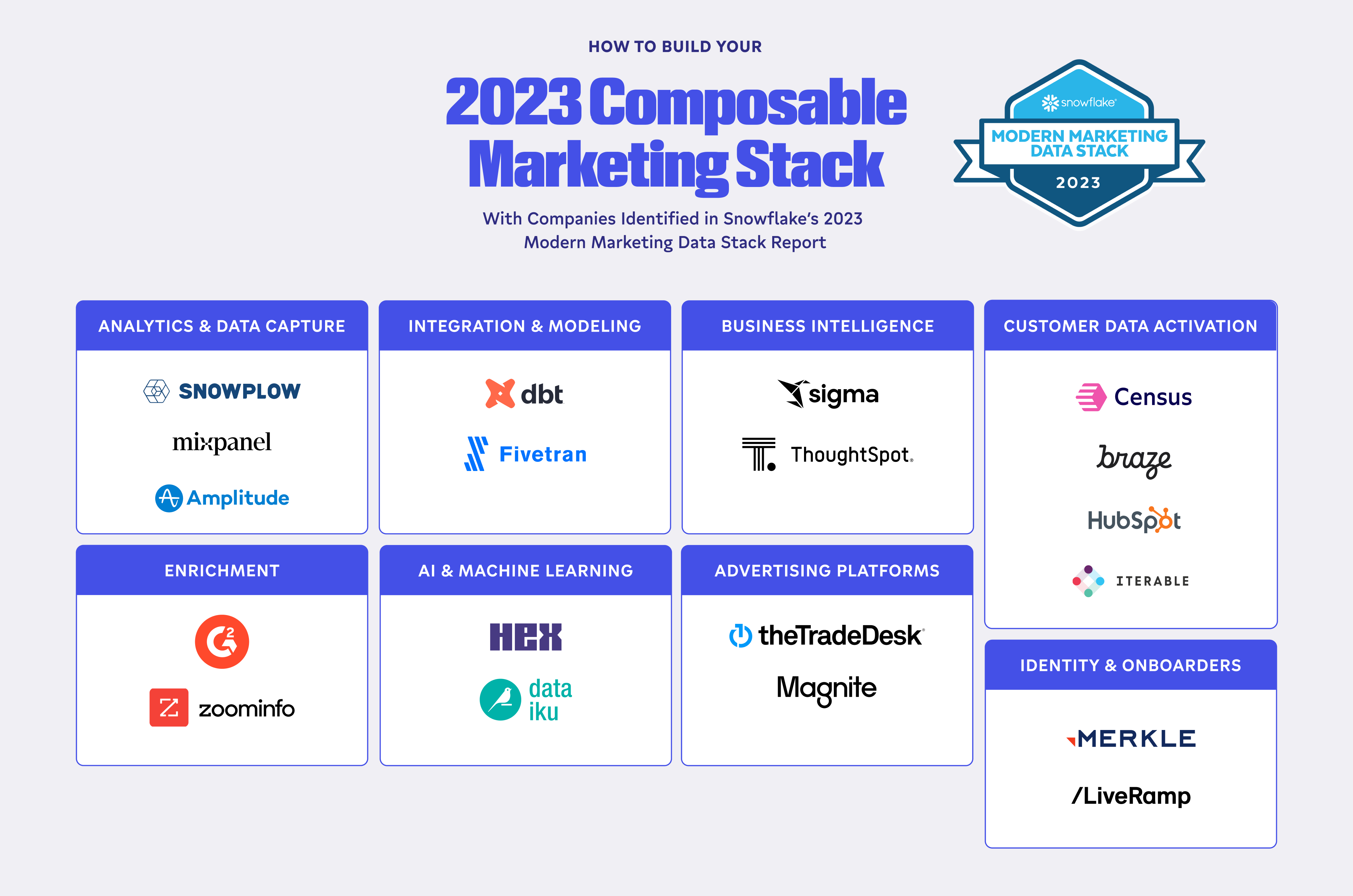Introduction
Unlocking the power of data is crucial for businesses to move forward into a new era of marketing. Customers, both B2C and B2B, are becoming more cautious and demanding in their spending and buying experience. Thus, resource-constrained marketers can only reach the right customers through carefully targeted messages, personalization, and segmentation.
Composable marketing technology, which is designed to work seamlessly with customer data and with other marketing solutions (especially fast-developing AI capabilities) will be essential to these goals.
Today, Snowflake named Census a Leader in Customer Data Activation in their 2023 Modern Marketing Data Stack for our ability to help global enterprises activate customer data. 🎉 Snowflake analyzed usage patterns from over 8,000 customers to recommend the right solutions that brands should use alongside the Data Cloud to create a single source of truth.
We put this blog together to highlight fellow best-of-breed partners in composable marketing, as identified by Snowflake's customer base.
Best Tools for Customer Data Activation
Census
Census is a Data Activation platform powered by Reverse ETL, transforming data warehouses into a hub for marketing activation and empowering non-technical business users to take data-driven action.
Braze
Braze is a comprehensive customer engagement platform that allows brands to ingest and process customer data in real time to orchestrate and optimize contextually relevant, crosschannel marketing campaigns.
HubSpot
HubSpot is an AI-powered customer platform that drives connection across the buyer journey for marketing, sales, and service teams.
Iterable
Iterable is the AI-powered, cross-channel communication platform helping to orchestrate individualized, harmonized, and dynamic customer experiences by closing the activation gap.

|
Best Tools for Analytics & Data Capture
Mixpanel
Mixpanel provides fast self-serve analytics, allowing organizations to join Mixpanel data with existing data environments to understand user behavior and key metrics like conversion and retention.
Amplitude
Amplitude is a low code/no code digital analytics platform leveraging user-based behavioral reports so non-technical team members can act on data.
Snowplow
Snowplow's Behavioral Data Platform allows marketing and data teams to create and operationalize rich, first-party customer behavioral data to fuel advanced data-driven use cases in near real time.
Best Tools for Integration & Modeling
Fivetran
Fivetran is an automated data movement platform moving data out of, into, and across cloud data platforms so that data teams can focus on delivering analytics, rather than building and maintaining pipelines.
dbt
dbt is a data transformation framework that uses software engineering best practices such as testing and version control to reduce code, automate dependency management, and ship more reliable data—all with SQL or Python.
Best Tools for Advertising
The Trade Desk
The Trade Desk is a media buying platform for advertisers and agencies to leverage data to buy media across the open internet.
Magnite
Magnite is an independent sell-side advertising company that helps publishers monetize their content across all screens and formats including CTV, online video, display, and audio.
Best Tools for Business Intelligence
Sigma
Sigma is a cloud-native analytics platform named 2023 Snowflake Business Intelligence Partner of the Year. Sigma's intuitive spreadsheet interface empowers business users to collaborate and make data-driven decisions through self-service BI.
ThoughtSpot
ThoughtSpot makes data insights actionable through an interactive and intuitive platform, delivering analytics and BI capabilities to users of any technical skill level.
Best Tools for Identity
Merkle
Merkle's Merkury is a customer experience management platform that identifies anonymous customers as a cookieless ID, enhances the ID with person-based data, and connects those IDs to platforms for targeting and analysis.
LiveRamp
LiveRamp uses a native application in Snowflake to help businesses to onboard, identify, connect, unify, control, and activate data across different channels and devices to optimize marketing efforts.
Best Tools for Enrichment
G2
G2 allows customers to enrich existing records with real user reviews, buyer intent signals, and access to competitive insights. Census is the G2 Leader for Reverse ETL!
ZoomInfo
ZoomInfo helps companies find, acquire, and grow customers faster by enriching CRM lead and contact data with first-party and third-party B2B data on existing records.
Best Tools for AI & Machine Learning
Hex
Hex's platform for collaborative analytics and data science combines multi-player notebooks supporting SQL, Python, R, and no-code with data apps and knowledge management, helping teams to do more with data together.
Dataiku
Dataiku offers processing flexibility with its ML model management capabilities, and cloud optimized, enterprise-ready AI solutions, which lets technical and non-technical users build, deploy, and monitor data science projects.
Read Snowflake's 2023 Modern Marketing Data Stack Report here.


















